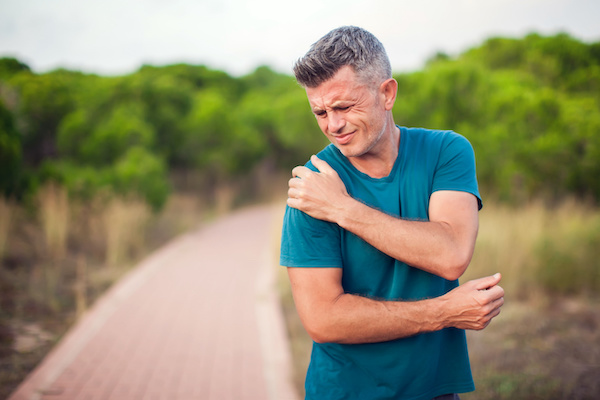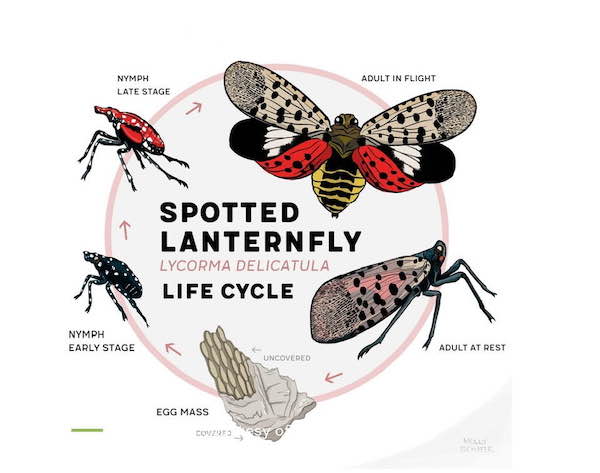Freeing Patients from Shoulder Pain
- Details
- Written by Joanne Wallenstein
- Category: Health
 The following was submitted by Dr. Michael Gott from White Plains Hospital
The following was submitted by Dr. Michael Gott from White Plains Hospital
Often when a patient hears the words “shoulder replacement,” they fear it means a loss of shoulder mobility for months and a long rehabilitation. Not so, assures Dr. Michael Gott, an Orthopedic Surgeon in the Center for Orthopedics and Spine Surgery at White Plains Hospital.
“Because it is not as common as knee or hip replacements, the misconception arises that this surgery entails removing and reattaching bones, tendons, and muscles,” he says. In fact, the procedure is technically a shoulder resurfacing, replacing just millimeters of damaged arthritic bone. During the procedure, Dr. Gott, guided by a CT scan, makes a tiny incision in the upper arm to insert a smooth titanium-alloy implant.
“CT-guided shoulder resurfacing is life-changing for those with end-stage shoulder arthritis, where the cartilage has worn away to create painful bone-on-bone friction,” says Dr. Gott.
Many of the patients the surgeon treats have had prior surgeries, multiple shoulder dislocations or just significant arthritis. Heavy lifting on the job or at the gym can exacerbate the pain. Some patients can no longer even lift their arms all the way up. These patients have exhausted all other options before electing to have the surgery.
“Injections only work for a few weeks or months, and medications have their own side effects,” Dr. Gott says. “And while physical therapy can be helpful for certain shoulder issues, it doesn’t address the damage to the joint that characterizes arthritis.”
For patients hesitant to embrace the idea of resurfacing, Dr. Gott points out the following advantages:
OUTPATIENT PROCEDURE. The patient receives local nerve blocks to numb the affected shoulder, undergoes an hour-long procedure, then receives a sling and returns home the same day. “Shoulder resurfacing requires fewer pain medications and a shorter recovery than even arthroscopic rotator-cuff repairs,” he explains.
MINIMALLY INVASIVE. Technological breakthroughs allow for tiny incisions and implants, removing a slice of bone that can fit on a fingernail. Rather than force metal into the bone, Dr. Gott slides titanium implants close to the joint.
PRECISION APPROACH. Dr. Gott’s team often creates 3D-printed models of a patient’s shoulder in advance to guide their approach during the procedure. “Studying the model cuts down on operating time and enhances accuracy. This focus on precision makes our outcomes even better,” he says.
RAPID RECOVERY. “As soon as they start physical therapy, patients tell me that they see a noticeable improvement in their strength and ranges of motion. They are also sleeping better within weeks, as opposed to months,” he notes. Following the procedure, patients typically require three months of supervised physical therapy, followed by exercises performed on their own as needed. They can then return to non-weight-bearing physical activities, such as golf, tennis, pickleball and racquet sports.
LOGISTICAL EASE. “Patients receive their consultations, CT scans, surgery, and follow-up care in the same location at our state-of-the-art Center for Advanced Medicine and Surgery,” Dr. Gott says. In addition to convenience, getting to know the care team promotes peace of mind for patients.
 In the end, Dr. Gott’s patients say they are grateful to have shrugged off their anxiety. “The most common feedback I hear from patients is that they only wish they had done the procedure sooner,” he says. “They not only recover — they bounce back even better.”
In the end, Dr. Gott’s patients say they are grateful to have shrugged off their anxiety. “The most common feedback I hear from patients is that they only wish they had done the procedure sooner,” he says. “They not only recover — they bounce back even better.”
Dr. Michael Gott Dr. Michael Gott is an orthopedic surgeon at the Center for Advanced Medicine and Surgery in White Plains. To make an appointment, call 914-849-7897.
Health Matters: The original version of this article was published in Health Matters, a White Plains Hospital publication.
Understanding Juvenile Arthritis
- Details
- Written by Joanne Wallenstein
- Category: Health
 This article was submitted by Dr. Tamar Rubinstein, Pediatric Rheumatology at White Plains Hospital
This article was submitted by Dr. Tamar Rubinstein, Pediatric Rheumatology at White Plains Hospital
Although arthritis is commonly associated with older people, it can also impact children. In fact, arthritis is the most common rheumatologic condition to affect children.
Juvenile arthritis (JA) refers to a group of autoimmune and inflammatory conditions that affect children under the age of 16. Just like arthritis in adults, JA involves chronic joint inflammation, which leads to stiffness, swelling, and pain. While some arthritis in children is associated with infectious causes such as Lyme Disease (caused by deer tick bites), the exact causes of JA remain largely unknown, but are likely a combination of genetic, environmental, and immunological factors.
The most common form of JA is Juvenile Idiopathic Arthritis, which according to the Arthritis Foundation is estimated to affect more than 300,000 kids in the U.S.
But other diseases can also lead to arthritis in children, including lupus, inflammatory bowel disease, and other, rarer autoimmune diseases.
The symptoms of juvenile arthritis may vary from child to child, but they often include joint pain, swelling, tenderness, morning stiffness, limited range of motion, and difficulty with everyday activities. Since these symptoms can mimic other conditions, a thorough evaluation by a pediatric rheumatologist is crucial for an accurate diagnosis. While the physical exam, evaluation, and careful review of the patient’s medical history are the most important part of diagnosing JA, sometimes blood tests and imaging scans help secure the diagnosis and ensure the differentiation from other mimickers of arthritis.
Although there is currently no cure for juvenile arthritis, early diagnosis and treatment is critical to manage symptoms, prevent joint damage, and improve a child’s quality of life – not only during childhood, but as they grow into adulthood. Treatment plans are tailored to the individual child and may involve oral medications, injectable medications, joint injections, and physical therapy.
Major advances in the treatment of autoimmune diseases and JA have been made over the past several decades, including the use of “biologics,” the newest class of medications used to treat JA. Encouraging a well-balanced diet, regular exercise, healthy sleep, and stress management are all important aspects of ensuring that children with JA achieve, and remain in, optimal health.
It should also be noted that JA can take a serious emotional toll on children and families. It is not uncommon for children with JA to struggle with anxiety or depression. These symptoms can seriously impact a child’s development, social wellbeing, and even their physical health. But when mental health symptoms are detected early, they can be addressed and treated to ensure that children with JA have the best possible long-term physical and emotional health outcomes.
Strategies to partner families with social and emotional support are especially important in youth who have JA. Professional mental health support, JA support groups and JA peer mentorship, and community resources all play an important role. To learn more about JA, you can visit the Arthritis Foundation webpage. Information about JA support groups can be found here.
To learn more about JA, you can visit the Arthritis Foundation webpage. Information about JA support groups can be found here.
Dr. Tamar Rubinstein is a Pediatric Rheumatologist at the Children’s Hospital at Montefiore (CHAM) who also sees patients at White Plains Hospital’s Montefiore Pediatric Subspecialty office at 33 Davis Ave. in White Plains. To make an appointment, call 914-849-5437.
Health Matters
The original version of this article was published in Health Matters, a White Plains Hospital publication.
Treating Joint Pain in a Natural Way
- Details
- Written by Joanne Wallenstein
- Category: Health
 Contributed by Dr. Nicole Solomos, Lifestyle Medicine. The original version of this article was published in Health Matters, a White Plains Hospital publication.
Contributed by Dr. Nicole Solomos, Lifestyle Medicine. The original version of this article was published in Health Matters, a White Plains Hospital publication.
Nagging joint pain can affect not just your body, but also your mind and your mood. As a result, many people suffering from joint pain do so by remaining relatively sedentary, afraid that engaging in physical activity will only exacerbate their situation.
However, as a practitioner of lifestyle medicine, I strongly recommend that everyone – and not just those with joint pain – follow certain regimens that can help them change their lives for the better. Lifestyle medicine is a medical specialty that uses therapeutic lifestyle interventions as a primary technique in treating chronic conditions.
For the purposes of this article, I will be speaking in generalities; obviously, each individual is facing their own situation, and some are more capable of making these adjustments than others. Nevertheless, following these recommendations can help those with joint pain feel refreshed, renewed, and more able to deal with their challenges.
Regular physical activity/exercise. This cannot be stressed enough. Such activity can keep the muscles around affected joints strong, slow the loss of lean mass, and in some cases can help control joint swelling and pain. In addition, regular activity can help restore lubrication to the cartilage of the joint, thereby reducing stiffness and pain.
This proposal may strike some – especially the elderly and/or those with severe joint pain – as difficult to achieve. But that is not necessarily the case. Strength training, which has not been emphasized enough in our culture, can be done at any age (it’s never too late to start!) and doesn’t necessarily mean lifting large barbells or dumbbells over your head repeatedly. Body weight exercises like push-ups or modified squats can be a great way to start; there is a host of exercises utilizing chairs for extra support. Resistance training, done with resistance bands, sandbags, or even some household items are also recommended, as are core exercises like planking or others that involve lying on your back.
Remember: strength and mobility can be more important than emphasizing one’s weight or body size; they can even go hand in hand. You aren’t looking to compete in the next Iron Man; you are looking to get more fit and relieve the stress on your aching joints.
Nutrition. Defining what makes for a “proper” nutrition plan can be complicated; there is no one way that’s right for everyone. For that reason, I recommend that each person comes up with their own customized eating plan rather than relying solely on someone else’s suggestions. The latter will usually prove to be unsustainable, and you might simply give up after a few weeks or months.
That said, I consider the Mediterranean diet to be the gold standard, with its emphasis on plant-based foods and healthy fats; details can be found here. Processed foods should be avoided, and you should be aware that your preferred intake of protein will vary as you get older, especially for women; those in peri- or post-menopause should be eating differently than those who are pre-menopause.
Risky substances. We all know (or should know) that smoking is a habit that should not be indulged. The same is true for alcohol; despite its normalization in our society – how many beer commercials do you see during a televised sporting event? – I feel that alcohol should be cut out of one’s life entirely. I realize that isn’t a particularly popular notion, but if you can’t keep it down to 0 drinks a week, try to limit it to no more than two drinks a day for men and no more than one drink a day for women, as the CDC suggests.
Caffeine is also a risky substance. Again, moderation is key; I feel that a single cup in the morning should be sufficient. Otherwise, you may be prone to feeling jittery/nervous, dehydrated, and/or having an increased heart rate. Too much caffeine or alcohol can have a negative impact on your sleep – and, thus, on your joint pain.
Sleep. An adequate amount of sleep allows your body to maintain healthy brain function and good physical health. Joint pain can result in restless sleep – without movement, your joints can stiffen during the night – and a lack of sleep can aggravate the pain. The exercises and other healthy habits listed above can help alleviate this problem.
Less than the recommended 7 to 8 hours a night may increase your chances of not only exacerbating joint pain, but also in developing chronic health problems. Dr. Nicole SolomosWater. Drinking enough water each day is one of the keys to sustaining a healthy lifestyle. The general guideline here is to take in at least 64 ounces of water a day (age, sex and activity levels may alter that recommendation). Water helps in maintaining healthy tissue as well as healthy joints. Water also is an excellent alternative to alcohol for a number of reasons; in addition, it can help fill you up, thus eliminating the urge for between-meal snacks.
Dr. Nicole SolomosWater. Drinking enough water each day is one of the keys to sustaining a healthy lifestyle. The general guideline here is to take in at least 64 ounces of water a day (age, sex and activity levels may alter that recommendation). Water helps in maintaining healthy tissue as well as healthy joints. Water also is an excellent alternative to alcohol for a number of reasons; in addition, it can help fill you up, thus eliminating the urge for between-meal snacks.
Following these guidelines will probably not eliminate your joint pain, especially if you have a chronic condition like arthritis. But it can definitely help alleviate at least some of it, which in turn will result in feeling both happier and healthier.
Dr. Nicole Solomos is board-certified in Sports Medicine/Family Medicine and in Lifestyle Medicine. To make an appointment, call 914-849-7075 (Somers) or 914-631-7777 (Hawthorne and Yonkers).
How to Get Rid of Spotted Lanternflies
- Details
- Written by Joanne Wallenstein
- Category: Health
 There’s no denying it. The invasive Spotted Lanternflies are here. Before they eat up our trees and gardens what can we do? Practically speaking, how do we eliminate these harmful pests?
There’s no denying it. The invasive Spotted Lanternflies are here. Before they eat up our trees and gardens what can we do? Practically speaking, how do we eliminate these harmful pests?
Here’s a list of helpful recommendations from the French and Pickering Creeks Conservation Trust French and Pickering Creeks Conservation Trust on how to get rid of the invaders:
Smushing the bugs is effective and the method that is least harmful to the environment. If the flies are on a hard surface, fly swatters and whiffle ball bats work. If you miss the first time, DON’T GIVE UP! Lanternflies jump GREAT the first time, not so good the second time, and then they lose energy. If you follow the bug, you will get it on the second or third try! Always try to come at the bugs from in front; they see better behind them. For the techies out there, there are special electric tennis rackets made for this – Zap-It, twin bug zappers – the first zap stops them from flying, then you can squash or zap again.
Smush again! If you are outside without your fly swatter, and you see one bug and want to smush it, this technique is foolproof (but not good if you are squeamish). Very, very SLOWLY, put one hand in front of the bug. Very, very SLOWLY, put one hand behind the bug. Very, very SLOWLY, bring your back hand towards your front hand until you have the bug trapped between your hands. You can then squish it, step on it, or drop it in a jar or tub of water and quickly put the lid on.
Another method for catching many adults on a tree or on the side of a house is to use a shop vac. A shop vac will suck them up quickly and they will be gone. If you don’t own a shop vac, you can buy a small bucket-sized one on Amazon or in many local stores.
The sticky paper plus hose method: If you have a tree with a bad infestation of lanternflies, wrap wide sticky paper or several strips of thinner sticky paper or inside-out duct tape around the bottom of the tree. Get out your hose or pressure washer and spray the bugs with water – or get out your leaf blower and spray the bugs with air – or knock the tree limbs with a broom – so they fall off the tree. They will scramble to climb back up the tree, and they will get caught on the sticky paper. You may need to replace the sticky paper if it starts to fill up with lanternflies. Once most of the bugs have returned to the tree and been captured, remove the paper from your tree and fold it back on itself. Never leave sticky paper unattended because it can harm beneficial insects and birds and other wildlife.
Bug Assault is a gun that shoots table salt at close range, and it works great on lanternflies. Here is a link to one that works: With older flies, the first shot may not kill them, but it will stun them, and then you can squish or step on. Air guns and BB guns with no BB’s also kill them! To quote: just pump 4 to 5 times, get really close to them and pow, blown to smithereens!!
Plant more milkw Experts suggest the removal of invasive Alianthus trees (Tree of Heaven) as they attract Spotted Lanternflies.Alinathus Tree, or Tree of Heaven is an invasive tree that attracts Spotted Lanternflieseed! It appears that the lanternflies are attracted to Common Milkweed. We find dead lanternflies on it every day. The lanternflies are new here, and they don’t know it is poisonous, so they eat it and it kills them. The poisonous sap also slows them down, so they are much easier to catch and smush in your hand. At the very least, you will be helping save the Monarch Butterfly and helping other pollinators, who love the flowers.
Experts suggest the removal of invasive Alianthus trees (Tree of Heaven) as they attract Spotted Lanternflies.Alinathus Tree, or Tree of Heaven is an invasive tree that attracts Spotted Lanternflieseed! It appears that the lanternflies are attracted to Common Milkweed. We find dead lanternflies on it every day. The lanternflies are new here, and they don’t know it is poisonous, so they eat it and it kills them. The poisonous sap also slows them down, so they are much easier to catch and smush in your hand. At the very least, you will be helping save the Monarch Butterfly and helping other pollinators, who love the flowers.
If you are dying to spray them with something, these pesticides are endorsed by Penn State as excellent at killing them on contact, but they don’t stay long on surfaces, so they should do the least harm to the beneficial insects we need: Purely Green, Spotted Lanternfly Killer 2 (active ingredient essential oils); Bonide Neem Oil (active ingredient Neem); Garden Safe Multi-Purpose Garden Insect Killer, Natria Insect Mite and Disease Control (active ingredient natural pyrethrins; and Garden Safe Insecticidal Soap (active ingredient insecticidal soap).
Don’t remove your spider webs! Spiders are catching lanternflies in their webs every day. Some of our spiders are learning to eat them. They will do lanternfly removal for you.
Remove Tree of Heaven from your property and replace it with a native tree. There is a strong relationship between Tree of Heaven (Ailanthus) and the Spotted Lanternfly – they love it. Tree of Heaven is an invasive, noxious plant that produces ailanthone, a chemical which has been reported to possess herbicidal activity similar to glyphosate (Round-Up) and paraquat. It prevents native plants from growing around it. Removing Tree of Heaven from your property is always a good idea. You may need a professional to do this.
When trying to handle a nymph: Leave out trays of water. Some people add some lemon oil. For some reason, they climb in the tray and drown. Our use The Tupperware Tub method – you can catch oodles of nymphs in a very short time. You will need a Tupperware tub, margarine container, or large yogurt container with a tight-fitting lid. Put a couple inches of a 50/50 mix of vinegar and water in the bottom. Hold the tub under a branch on which there are nymphs. Tap the branch from above, the nymphs fall in the liquid, slap the lid on, and the nymphs will drown within 15 seconds. You can save the liquid for next time. Remember, never pour this liquid on the ground – pour it down your garbage disposal or toilet.
Spotted Lanternfly Eggs Masses start appearing in early fall. They are grey or brown globby 2-4″ smears that look a bit like old chewing gum on trees, cement blocks, rocks, cars, houses, barbecue grills – any hard surface. The good news is this is the easiest phase to get rid of – you can scrape them off using a plastic card, like a credit card or a putty knife. Scrape them into a small baggie or container filled with isopropyl alcohol or hand sanitizer. This is the most effective way to kill the eggs, but they can also be smashed or burned. Remember that some eggs will be laid at the tops of trees and may not be possible to reach.
Do you have ideas on how to get rid of lantern flies? Post them in the comments section below:
Tips for Men’s Health
- Details
- Written by Joanne Wallenstein
- Category: Health
 This article was written by Dr. Matthew Zeppieri, Family Medicine
This article was written by Dr. Matthew Zeppieri, Family Medicine
Remembering to prioritize your physical and mental health can be challenging, especially while balancing work, social life, and family. Despite this, it is important for men to follow some basics in order to remain healthy and prevent future illness.
1. Attend Annual Physicals
Given the high likelihood of prostate and colon cancer in men, it is important to schedule annual physicals. In addition to prostate cancer, colorectal cancer is more common in men. While men and women are essentially equally at risk for colon cancer, men are more likely to get rectal cancer, according to the Centers for Disease Control and Prevention (CDC). Both prostate and colorectal cancer screenings can be critically important, as the earlier those diseases are detected, the better the chances of successfully treating them.
With patients under 40, I inquire if they are experiencing any typical prostate cancer symptoms, including multiple trips to the bathroom at night to urinate; general frequency and urgency associated with urinating; and hesitancy or weakening of the urine stream. Other concerning indications include unexplained fevers and/or unintentional weight loss.
With patients over 40, I recommend conducting a Prostate Specific Antigen (PSA) screening and a digital rectal exam. Although some patients are more resistant to these procedures that others, there is value in conducting these screenings and catching these illnesses early on.
With colon cancer, since we are finding an increase in cases of younger men, the recommended age for a colonoscopy has been lowered from 50 to 45. In addition, if an individual has a family history of colon cancer, it is recommended that a screening be done 10 years prior to when that family member’s diagnosis took place.
2. Active Lifestyle
The American Heart Association recommends 150 minutes of moderate exercise weekly. This type of exercise includes any activity other than sitting at a desk – including, but not limited to, household chores or going for short walks.
Another option to maintain an active lifestyle is 75 minutes of vigorous exercise weekly. This type of exercise includes a more intense regimen like jogging, swimming, playing racquetball, etc. With both of these options, the overarching goal is to remain active regardless of the ways in which that activity is accomplished.
3. Balanced Diet
Maintaining a balanced diet and consuming the appropriate amount of calories can be difficult, given the multitude of different diet options and discussions around calorie intake. Daily calorie intake recommendations are 2,400 for those aged 21 to 40; 2,200 for those aged 41 to 60; and 2,000 for men aged 61 and older. To lose one pound a week, those numbers can be decreased by 500 calories.
I recommend accurately counting your calorie intake. It is important to be honest with your physician and yourself when calorie counting, as inaccurate reporting does not help your physician – or, more importantly, yourself.
A diet that I and many other physicians recommend is the Mediterranean diet, which emphasizes plant-based foods and healthy fats. Additional details can be found here. 4. Monitor Mental Health
4. Monitor Mental Health
Checking up on the mental health of my patients is a priority. Every time I see a patient, I always inquire about feelings of depression, anxiety and stressors in their lives. Given the still-present stigma around their emotional needs, it can be hard for some men to openly discuss their mental health with their physician. Despite this, it is imperative to have these discussions with your physician, instead of allowing an illness to remain untreated.
Again, it is vital to prioritize receiving your annual physical and age-appropriate screenings as a preventative measure to remain safe and healthy. If you have not already done so, I urge you to schedule any visits that you may have let slip by; your doctor, and your body and mind, will thank you.
Dr. Matthew Zeppieri is a family medicine physician at White Plains Hospital Physician Associates of New Rochelle. For an appointment, call 914-235-8224.














